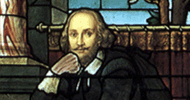

 |
 |
| Authorship | The Playhouse in Printing House | Publishers, Printers, and the Printed Book | ||||||||||||
| The Playhouse in Printing House | |||
| Woodcuts From Plays | ||
|
Publishers sometimes commissioned illustrations to adorn the title pages of plays. These illustrations could take the form authorial portraits, but individual play quartos more frequently included a woodcut from a scene in the play. The woodcut from The Spanish Tragedy (1633; originally published 1594) was first used in the play's seventh edition (1615). It shows the scene from the second act when Hieronimo comes upon the dead body of his son Horatio, and Lorenzo, the Duke of Castile's son, orders his sister Bel-Imperia's mouth to be stopped. The woodcut for Friar Bacon and Friar Bongay (1630) was not part of the play's first edition in 1594, but instead appeared in the prose history The famous historie of fryer Bacon, published in 1627 and 1629 by Francis Grove (STC 1183, 1184). Grove used Elizabeth Allde to print the 1629 history of Friar Bacon, and presumably she borrowed the woodcut from Grove for her edition of the play a year later. The woodcut is from act five and is meant to show the brass head speaking, "Time is. Time was. Time is past," while Friar Bacon and his servant sleep. In fact, the woodcut reads "Time is. Time is. Time is past," a small error that was corrected during the play's printing; other copies have the correct reading. On the left is a clown from a different scene who resembles the comic actor Will Kemp. |
Images: Columbia
Rare Book & Manuscript Library
Technology: Columbia Center for New
Media Teaching & Learning